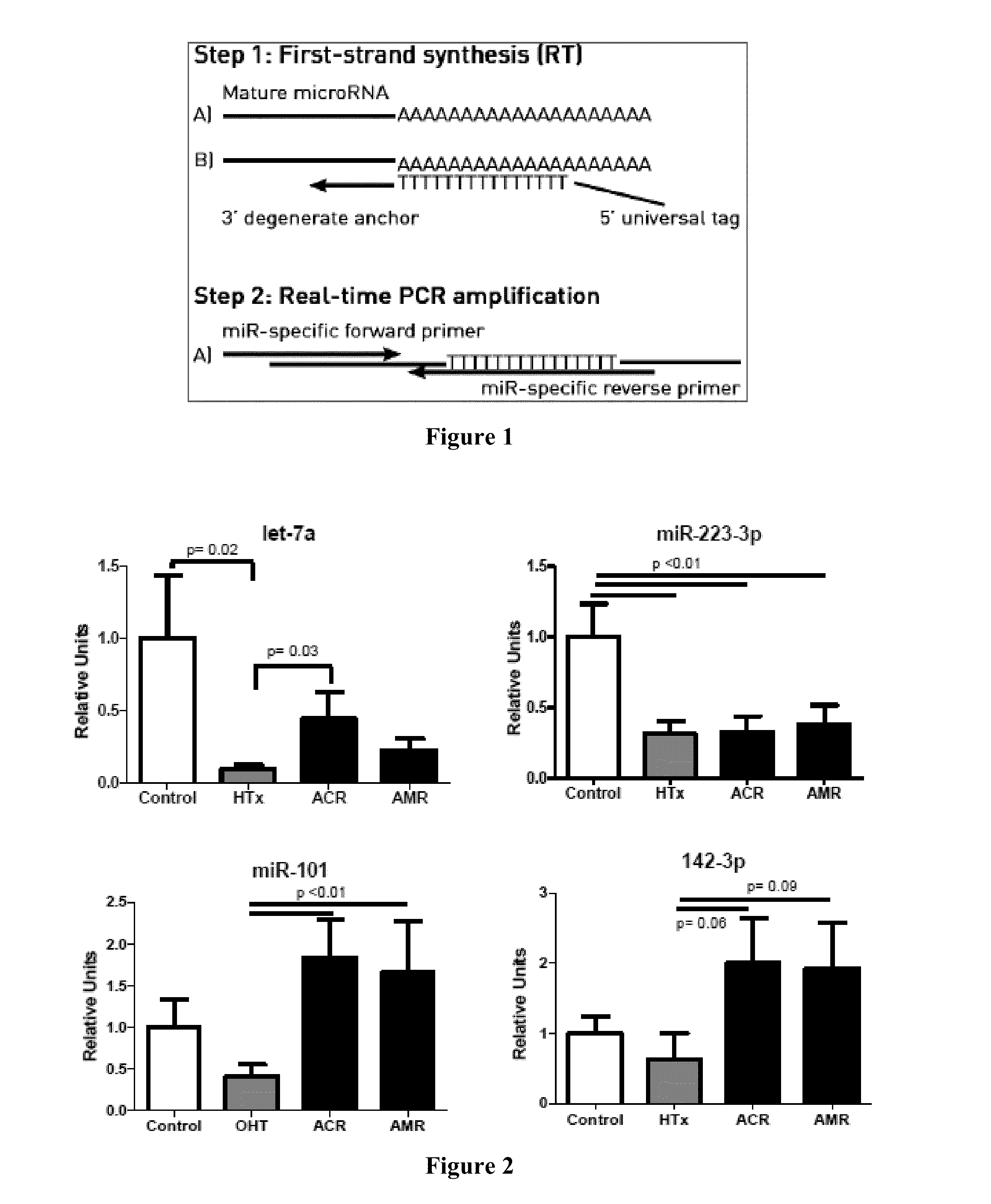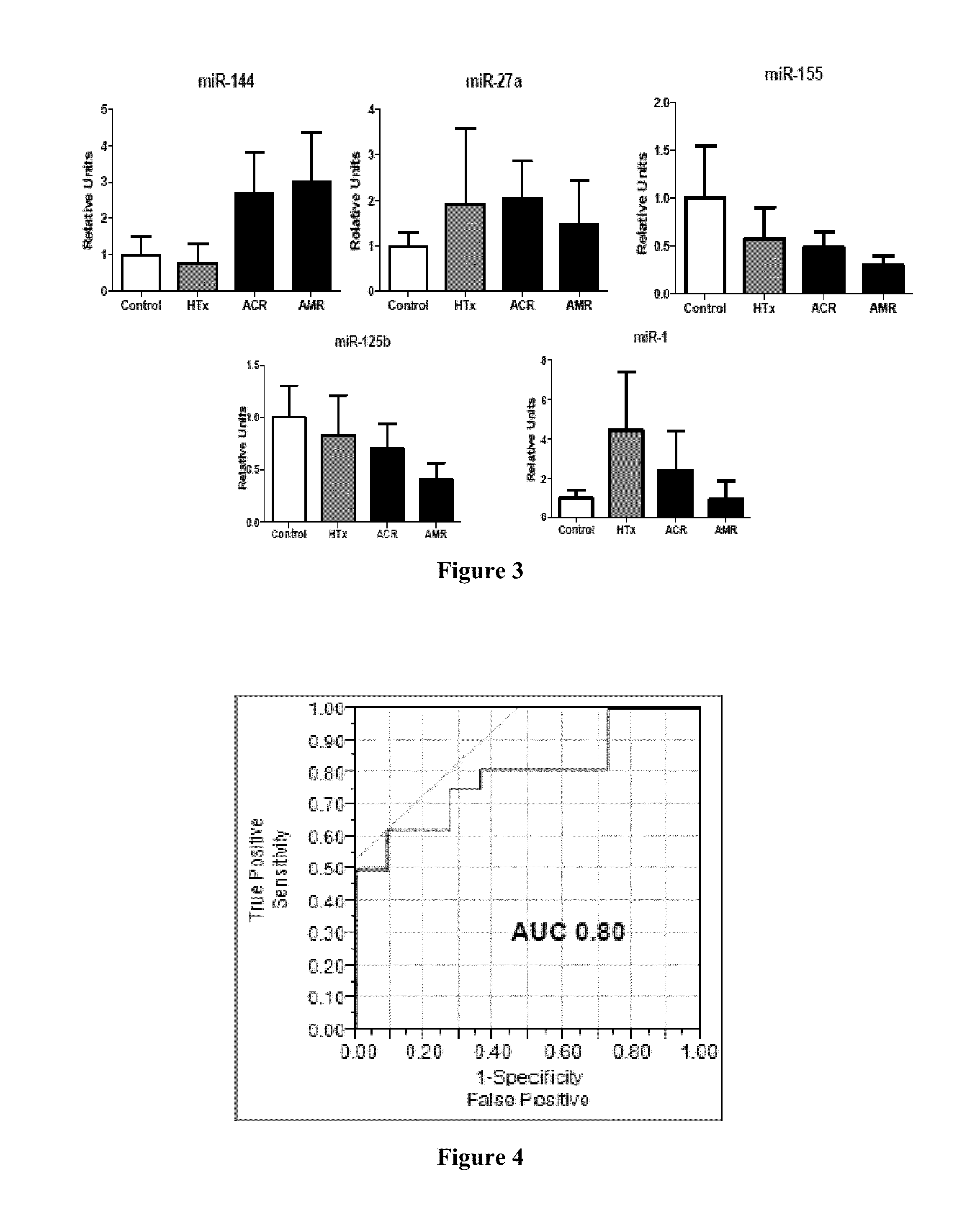Circulating Non-coding RNA Profiles for Detection of Cardiac Transplant Rejection
a non-coding, rna-based technology, applied in the field of detection of micrornas, can solve the problems of high morbidity and significant mortality, ineffective conventional therapies in many patients, and heart failure (hf)
- Summary
- Abstract
- Description
- Claims
- Application Information
AI Technical Summary
Benefits of technology
Problems solved by technology
Method used
Image
Examples
example 1
[0111]We studied serum levels of miRs associated with immune cell function (miR-155, 125b, 142-3p, 144, 223-3p, 27a and 101), myocardial damage (miR-1) and immunosuppression (let-7a). We hypothesized that these miRs would be associated with acute cellular rejection (ACR) and antibody-mediated rejection (AMR).
Methods
[0112]Subject recruitment: Patients who received HTx at Columbia University Medical Center and gave informed consent were enrolled. Clinical data were obtained from patient charts. Samples were obtained from control subjects who gave informed consent.
[0113]Sample processing: Blood was obtained from HTx recipients >2 months post-HTx. Blood samples were centrifuged in EDTA-containing tubes at 1500× relative centrifugal force for 15 minutes. The plasma fraction was aspirated for further analysis. 200 μL of each plasma sample was then processed with an Exiqon miRCURY™ RNA Isolation Kit.
[0114]Rejection was defined by histology of cardiac biopsy specimens and graded according t...
example 2
[0134]We studied serum levels of miRs associated with immune cell function (miR-155, 125b, 142-3p, 144, 223-3p, 27a and 101), myocardial damage (miR-1) and immunosuppression (let-7a). Blood was obtained from HTx recipients >2 months post-HTx. Rejection was defined by histology of cardiac biopsy specimens and graded according to ISHLT guidelines. MiRs were analyzed with RT-PCR and normalized to 5S rRNA.
[0135]Blood samples were centrifuged in EDTA-containing tubes at 1500× relative centrifugal force for 15 minutes. The plasma fraction was aspirated for further analysis.
[0136]200 μL of each plasma sample was then processed with an Exiqon miRCURY™ RNA Isolation Kit.
cDNA Synthesis
[0137]2 μL of each eluate was mixed with 2 μL 5× reaction buffer, 5 μL nuclease-free water, and 1 μL enzyme mix, all components of the Exiqon Universal cDNA synthesis kit II (product #203301) at 4° C. The total reaction volume was 10 μL.
[0138]Each cDNA synthesis mixture was incubated for 60 minu...
example 3
[0143]We assessed serum levels of the cardiac miRNAs miR-1 and miR-101 and the immunologic miRNAs miR-155, miR-125b, miR-142-3p, miR-144, miR-223-3p, miR-27a, and let-7a by RT-PCR. Subjects included 12 healthy volunteers, 13 HTx recipients without rejection (mean age 52.3 yrs; 10 men, 3 women), 11 patients with ACR (mean age 48.5; 6M / 5W) and 5 patients with AMR (mean age 45.2; 2M / 3W). Blood samples were obtained >2 months post-HTx. All HTx recipients were receiving tacrolimus, prednisone and mycophenolate. Levels of miRs were normalized to 5S rRNA.
[0144]Results: Levels of miR-101 were significantly higher in ACR (p<0.05) compared to no rejection. Levels of miR-144 were significantly increased in both ACR and AMR. Levels of miR-223-3p were suppressed in all HTx recipients compared to control, regardless of rejection status. Let-7a, which is known to be suppressed by tacrolimus, was significantly suppressed among all HTx recipients and there were trends towards an increase among patie...
PUM
| Property | Measurement | Unit |
|---|---|---|
| volume | aaaaa | aaaaa |
| volume | aaaaa | aaaaa |
| volume | aaaaa | aaaaa |
Abstract
Description
Claims
Application Information
 Login to View More
Login to View More - R&D
- Intellectual Property
- Life Sciences
- Materials
- Tech Scout
- Unparalleled Data Quality
- Higher Quality Content
- 60% Fewer Hallucinations
Browse by: Latest US Patents, China's latest patents, Technical Efficacy Thesaurus, Application Domain, Technology Topic, Popular Technical Reports.
© 2025 PatSnap. All rights reserved.Legal|Privacy policy|Modern Slavery Act Transparency Statement|Sitemap|About US| Contact US: help@patsnap.com


